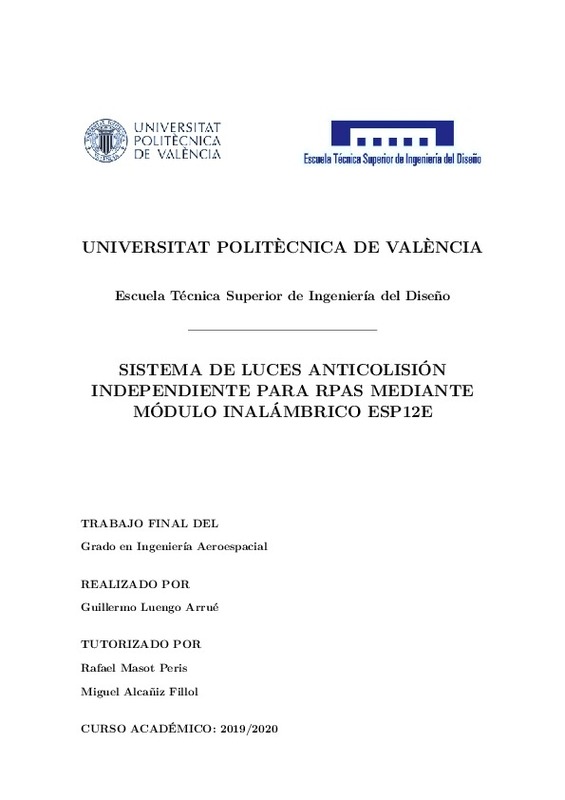JavaScript is disabled for your browser. Some features of this site may not work without it.
Buscar en RiuNet
Listar
Mi cuenta
Estadísticas
Ayuda RiuNet
Admin. UPV
Sistema de luces anticolisión independiente para RPAS (Remotely Piloted Aircraft System) mediante módulo inalámbrico ESP12E
Mostrar el registro sencillo del ítem
Ficheros en el ítem
| dc.contributor.advisor | Masot Peris, Rafael
|
es_ES |
| dc.contributor.advisor | Alcañiz Fillol, Miguel
|
es_ES |
| dc.contributor.author | Luengo Arrué, Guillermo Manuel
|
es_ES |
| dc.date.accessioned | 2020-07-29T09:40:48Z | |
| dc.date.available | 2020-07-29T09:40:48Z | |
| dc.date.created | 2020-07-08 | |
| dc.date.issued | 2020-07-29 | es_ES |
| dc.identifier.uri | http://hdl.handle.net/10251/148801 | |
| dc.description.abstract | [ES] La normativa de seguridad establecida en el Real Decreto 1036/2017, exige a las aeronaves no tripuladas que son operadas mediante control remoto con una envergadura menor de 3m, que estén dotadas de un sistema de luces anticolisión. Las recomendaciones tanto de la AESA (Agencia Estatal de Seguridad Aérea) como de la OACI (Organización de Aviación Civil Internacional) para obstáculos móviles, establecen que dichas luces deben ser amarillas, su frecuencia de parpadeo debe estar entre 60 y 90 ciclos por minuto y su intensidad lumínica efectiva superior a 17 cd. En el presente trabajo de fin de grado se ha llevado a cabo el diseño y fabricación de un sistema de luces anticolisión compacto, inalámbrico e independiente que puede ser instalado y removido del drone de forma rápida y sencilla obteniéndose así un producto que es capaz de satisfacer las exigencias determinadas por la normativa. El sistema se compone de cinco módulos basados en el dispositivo de comunicación inalámbrica ESP12E, cada uno de los cuales controla un LED de alta luminosidad. El módulo central envía una señal al resto de módulos para controlar de forma sincronizada el encendido de los LEDs. Se ha desarrollado un código en el entorno Arduido IDE que permite la comunicación entre los módulos y la configuración de la frecuencia de parpadeo de las luces. Se ha diseñado una placa de circuito impreso (PCB) que incorpora el módulo de comunicación ESP12E, el LED y su driver de potencia y el circuito de control de carga/descarga de la batería. También se ha diseñado, mediante software CAD, una caja para alojar todos los componentes. | es_ES |
| dc.description.abstract | [EN] According to the safety regulations established by the Real Decreto 1036/2017, all the unmanned aerial vehicles that are remote controlled and have a span lower than 3m, must be equipped with a lights anti-collision system. In this way, the recommendations issued by AESA (Agencia Estatal de Seguridad Aérea) and ICAO (International Civil Aviation Organization) for moving obstacles, point out the need for those lights to be yellow, with a blinking frequency between 60 and 90 cycles per minute and whose effective intensity must be greater than 17 cd. In this Final Degree Project, the process from the design to the manufacturing of a compact, wireless and independent lights anti-collision system has been carried out. Furthermore, it can be installed and removed from the drone in a fast and easy way, obtaining a product that is able to cover all the regulations determined by the authorities. The system itself is formed by five modules based on the wireless communication ESP12E, each of them controlling one high brightness LED. The central module sends a signal to the others so that the activation of the LEDs can be controlled in a synchronized manner. A computer code has also been developed in the Arduino¿s `Integrated Development Environment¿ (IDE) that allows the communication between the modules and sets the blinking frequency of the lights. Also, a Printed Circuit Board (PCB) has been designed. This one includes the communication module ESP12E, the LED, its power driver and the charge and discharge control circuit of the battery. Finally, a box has been created by means of CAD software and later 3D printing to gather all the components correctly. | es_ES |
| dc.format.extent | 77 | es_ES |
| dc.language | Español | es_ES |
| dc.publisher | Universitat Politècnica de València | es_ES |
| dc.rights | Reserva de todos los derechos | es_ES |
| dc.subject | Luces anticolisión | es_ES |
| dc.subject | RPAS | es_ES |
| dc.subject | Drone | es_ES |
| dc.subject | ESP12E | es_ES |
| dc.subject | Seguridad aérea | es_ES |
| dc.subject | Anti-collision lights | es_ES |
| dc.subject | Air safety | es_ES |
| dc.subject.classification | TECNOLOGIA ELECTRONICA | es_ES |
| dc.subject.other | Grado en Ingeniería Aeroespacial-Grau en Enginyeria Aeroespacial | es_ES |
| dc.title | Sistema de luces anticolisión independiente para RPAS (Remotely Piloted Aircraft System) mediante módulo inalámbrico ESP12E | es_ES |
| dc.type | Proyecto/Trabajo fin de carrera/grado | es_ES |
| dc.rights.accessRights | Abierto | es_ES |
| dc.contributor.affiliation | Universitat Politècnica de València. Departamento de Ingeniería Electrónica - Departament d'Enginyeria Electrònica | es_ES |
| dc.contributor.affiliation | Universitat Politècnica de València. Escuela Técnica Superior de Ingeniería del Diseño - Escola Tècnica Superior d'Enginyeria del Disseny | es_ES |
| dc.description.bibliographicCitation | Luengo Arrué, GM. (2020). Sistema de luces anticolisión independiente para RPAS (Remotely Piloted Aircraft System) mediante módulo inalámbrico ESP12E. Universitat Politècnica de València. http://hdl.handle.net/10251/148801 | es_ES |
| dc.description.accrualMethod | TFGM | es_ES |
| dc.relation.pasarela | TFGM\131250 | es_ES |
Este ítem aparece en la(s) siguiente(s) colección(ones)
-
ETSID - Trabajos académicos [8906]
Escuela Técnica Superior de Ingeniería del Diseño






